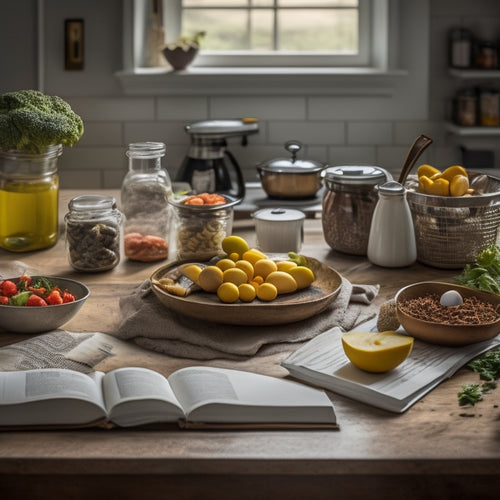
Upgrade Your Restaurant Kitchen With Essential Equipment
Share
You've got a solid kitchen concept, a talented team, and a loyal customer base, but outdated equipment is holding you back. To upgrade your restaurant kitchen, start by evaluating your current equipment and workflow, then prioritize quality equipment that meets safety standards and fits your budget. Focus on essential items like ovens, ranges, and ventilation systems, and consider multi-functional appliances to maximize efficiency. With a well-planned kitchen upgrade, you'll be able to increase productivity, reduce costs, and take your restaurant to the next level. Now, discover how to turn your vision into a reality with the right equipment and layout.
Key Takeaways
• Evaluate your current kitchen workflow and equipment to identify areas for improvement and prioritize upgrades.
• Invest in high-quality, durable ovens, ranges, ventilation, and charbroilers that meet safety standards and ensure efficiency.
• Consider multi-functional appliances that can increase productivity and reduce costs, while maintaining quality and consistency.
• Optimize kitchen layout to minimize walking distances, streamline workflow, and increase staff productivity with efficient equipment placement.
• Balance equipment cost with long-term durability, maintenance, and ROI to create a cost-effective kitchen that meets your unique needs.
Planning Your Kitchen Upgrade
When upgrading your restaurant kitchen, begin by evaluating your current equipment and workflow to identify areas for improvement, ensuring a smoother and more efficient operation.
Assess your budget management to determine how much you can allocate for new equipment and upgrades. Consider space utilization, taking into account the layout of your kitchen and the flow of staff. This will help you opt for space-saving and multi-functional appliances that won't obstruct workflow.
Additionally, prioritize equipment durability and warranty coverage to minimize replacements and repairs. By doing so, you'll create a more streamlined and cost-effective kitchen that meets your needs and helps you stay in control.
Investing in Quality Equipment
Having optimized your kitchen layout and workflow, you can now focus on investing in quality equipment that will help you maintain efficiency and consistency in food preparation.
When doing a cost analysis, consider the equipment's longevity and potential return on investment. High-quality equipment may seem expensive upfront, but it can save you money in the long run by reducing the need for frequent replacements.
Additionally, prioritize safety standards and usability concerns when selecting equipment. Look for appliances that meet food safety regulations and are easy to clean and maintain. Make certain that your staff can operate the equipment safely and efficiently, and address any usability concerns they may have.
Equipment Selection Essentials
You'll want to prioritize ovens, ranges, ventilation, and charbroilers as essential commercial equipment for your restaurant, as they form the backbone of your kitchen operations.
When selecting these must-haves, consider your restaurant's unique needs, such as the number of customers you serve and the type of cuisine you offer.
Don't forget to factor in equipment maintenance and budget-friendly options to guarantee you're getting the best value for your investment.
Look for durable, high-quality appliances that can withstand heavy use and won't break the bank.
Optimizing Kitchen Operations
To optimize kitchen operations, prioritize workflow efficiency by strategically positioning equipment to minimize walking distances and maximize productivity. This will lead to efficiency improvement and cost reduction.
By streamlining your kitchen layout, you can reduce labor costs, lower stress levels, and increase customer satisfaction. Workflow optimization also involves staff training, ensuring that your team is well-versed in kitchen operations and can work seamlessly together.
Invest time in training your staff on equipment usage, kitchen protocols, and communication strategies. This won't only improve kitchen efficiency but also reduce errors and waste.
Choosing the Right Appliances
By optimizing your kitchen operations, you've set the stage for choosing the right appliances that will streamline your food preparation and presentation, ultimately enhancing your customers' dining experience.
When selecting appliances, prioritize equipment durability and efficiency to make sure they can handle high-volume usage. Cost-effective choices are essential, so consider your budget and weigh the benefits of each appliance against its cost. Don't sacrifice quality for affordability, as it may lead to frequent replacements and increased expenses in the long run.
Look for appliances that offer multi-functional capabilities, are space-saving, and meet safety standards. By making informed decisions, you'll create a kitchen that's efficient, productive, and profitable.
Frequently Asked Questions
What Are the Most Common Kitchen Equipment Mistakes to Avoid?
When setting up your kitchen, you'll want to avoid common mistakes like neglecting maintenance tips, ignoring proper ventilation, and overcrowding the space, which can lead to safety hazards, inefficiency, and costly repairs down the line.
Can I Customize Equipment to Fit My Restaurant's Unique Needs?
"Cut to the chase" and explore customization options that cater to your unique needs. You can tailor equipment with specialized features, such as bespoke ventilation systems or modified cooking stations, to optimize your kitchen's workflow and productivity.
How Do I Prioritize Equipment Purchases on a Limited Budget?
When prioritizing equipment purchases on a limited budget, you'll need to focus on budget management and strategic equipment selection, opting for cost-effective upgrades and essential tools that maximize efficiency and productivity in your kitchen.
Are Energy-Efficient Appliances Worth the Extra Cost?
"A penny saved is a penny earned," so consider energy-efficient appliances, which may cost more upfront but yield long-term energy savings, making them a wise investment; weigh this against potential performance and reliability tradeoffs.
Can I DIY Kitchen Equipment Installation to Save Money?
You're considering DIY kitchen equipment installation to save money, but weigh the risks: incorrect installations can void warranties and compromise safety. Instead, customize equipment to fit your needs, and consider hiring a professional for a precise, efficient setup.
Related Posts
-

Why Keto Dieters Need a Meal Planning System
You need a meal planning system to supercharge your keto diet because without one, you'll be stuck in a vicious cycle...
